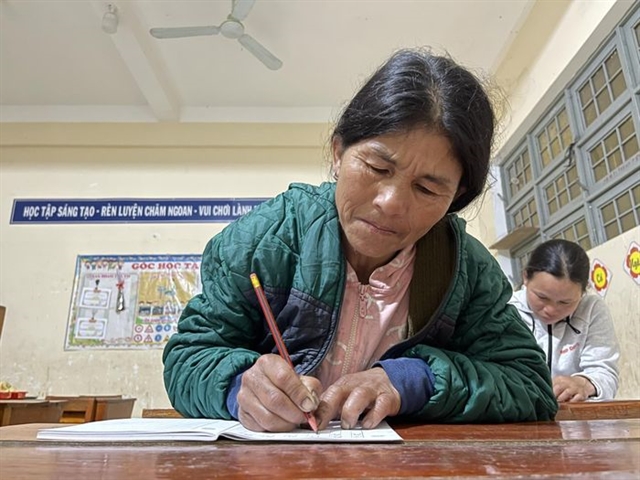 Society
Society

 |
| The calloused hands of the Xơ Đăng ethnic women hold a pencil to write for the first time. Photo congluan.vn |
KON TUM — Y Phiên, a woman from the Xơ Đăng ethnic minority group in the Tây Nguyên Central Highland province of Kon Tum, felt very embarrassed when she first time held a pen.
Every day at 6pm, she attends the Ethnic Semi-Boarding High School for an adult literacy class to learn how to read and write.
The 54-year-old woman from Đăk Chun Village, Măng Bút Commune, Kon Plông District, has never been able to read or write.
Phiên could not attend school because her family was so poor, and her parents had to work hard to earn a living.
The burden of food and money followed her until she married and gave birth to children.
“I've known how to hold a hoe since I was a child," Phiên told Nhà Báo & Công Luận (Journalists & Public Opinions) newspaper. "But I don't know how to hold a pen. I only use my fingerprint as signature,"
"I don't know how to write my name and feel very ashamed of my children and grandchildren. For many years, I have always wished to go to school to learn how to read and write. I'm so happy to take part in the literacy class."
She has to ask her children and grandchildren or commune officials for support in doing paperwork.
The youngest student is 35 years old, and the oldest is nearly 60. Many students in the special class have never been able to read and write. Some people used to learn writing and reading but have also forgotten.
Like Phiên, Y Xanh, a 39-year-old woman, cannot read and write.
Xanh even faces difficulty in simple calculations when she is buying or selling.
With encouragement from the local authorities and her desire to read and write for a long time, Xanh registered to participate in the literacy class when it opened in Măng Bút Commune.
After finishing her farming work, she goes home to do housework in the afternoon and gets ready for the literacy class in the evening.
Xanh also asked her youngest daughter to teach her how to write and spell after school.
“At first, I was shy when my daughter taught me," said Xanh. "But I try to overcome that shyness. A few days later, I could write simple letters but couldn't spell them properly. I will try to learn to calculate and apply science and technology to production.”
 |
| Teacher Đinh Ái Nga (left) helps her students write. Photo congluan.vn |
Teacher Đinh Ái Nga said there were 32 students in this special class.
“People are very excited to participate in the class," said Nga.
"Teaching them is like teaching the first graders. Most of the women are not of studying age, but they are all eager to learn new letters and maths."
"I feel very happy with their efforts in learning. I hope these students will come to class regularly. It would help them improve their lives."
Authorities in Kon Plông District have identified illiteracy eradication as an important task, aiming to improve people's knowledge.
They have promoted propaganda, raised people's awareness of literacy, and coordinated with agencies and the education sector to effectively implement the task of illiteracy eradication.
The district now has literacy classes in Đăk Ring, Măng Bút, Ngọk Tem and Hiếu communes, attracting hundreds of people.
All participants are from ethnic minorities aged 20 to 69.
The district Department of Education and Training has coordinated with schools to assign teachers to teach in classes to facilitate teaching. Literacy classes are open every Monday to Thursday evening.
Students are provided with books and pens. After completing the first to the third-grade course within 16 months, each person will be supported VNĐ500,000 (over US$21).
Following the guidance of the Government, the Ministry of Education and Training and the People's Committee of Kon Tum province has set out a plan to universalise education and eradicate illiteracy in Kon Plông District in 2022-2025.
The plan aims to improve education universalisation and illiteracy eradication, thereby improving the quality of education to meet the requirements of a comprehensive renovation of education and training, contributing to socio-economic development, according to Phạm Văn Thắng, vice chairman of Kon Plông District People's Committee.
"The locality strives to have 100 per cent of communes and township meet illiteracy eradication standards at level 2," the vice chairman said." The percentage of people between the ages of 15 and 60 that meet the illiteracy eradication standards at level 2 will reach 96.5 per cent."
"The number of people joining literacy classes will be 80-200 a year,"
Investment in facilities and school supplies would also be focused on improving the quality of teaching and learning in educational institutions, he said. — VNS